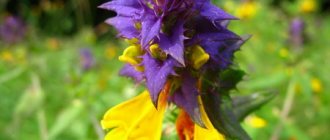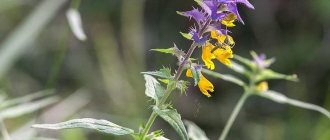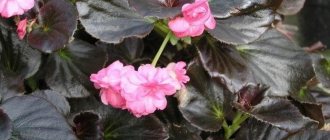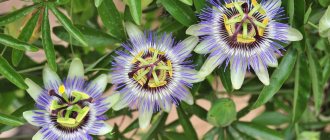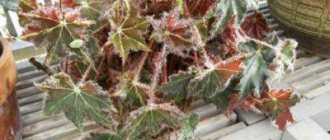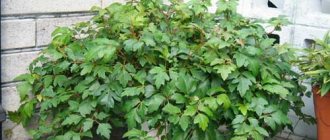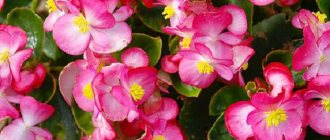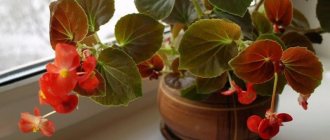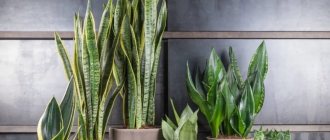Description of the flower
Ivan da Marya is an annual herbaceous plant that grows up to half a meter in height. The root system has specific suckers, thanks to which the flower attaches to other vegetation and lives on its juices. The erect stem, covered with white hairs, is characterized by branches. The ovate-lanceolate leaves are distinguished by their long-pointed shapes.
Each yellow flower is additionally decorated with a bract leaf of blue, violet, crimson or bright lilac color. At the end of the flowering period, which lasts throughout the summer, egg-shaped fruits are formed. Subsequently, the oblong seeds contained in the boxes serve as food for forest inhabitants.
Care
Ivan da Marya is an unpretentious and hardy flower. When grown at home or in the garden, it does not require much attention. There are only a few techniques that allow you to admire the lush flowering of the marianberry year after year.
Spraying
Additional foliar irrigation is useful only for plant varieties without pubescence. When spraying the home bush Ivan da Marya, you should not moisten the inflorescences. Water the maryannik regularly with soft water. Gradually increase humidity by May, water daily in hot weather, and reduce watering by mid-autumn.
Top dressing
Ivan-da-Marya bushes develop well in partial shade. For lush flowering, plants need only moderate sunlight and watering. Garden flowers do not need to be fed.
Home begonia, planted in a nutrient substrate, does not need feeding for several years. Fertilizers begin to be applied when the soil is clearly depleted. Complex ready-made fertilizers are used for flowering plants from the beginning of May to the end of October. In winter, Ivan da Marya is not fed.
Transfer
Move the plant to a new container only if it is necessary to replace the soil or the roots have outgrown. It is best to carry out the procedure in the spring, before the active growth phase. Mariannik does not tolerate transplantation well, so it may not bloom this season. The fragile roots of the plant are moved carefully; damage to them greatly weakens the bush and leads to pain or death of the begonia.
Trimming
Ivan da Marya bushes do not require special pruning or shaping. It is enough to remove withered leaves and shorten overgrown shoots. Pruning is mainly done to obtain green cuttings when it is necessary to propagate begonia.
Temperature and humidity
Ivan-da-Marya is a heat-loving flower and in its natural environment dies at the first frost. During the growing season, domestic begonia prefers moderate heat.
It is advisable to grow maryannik at a temperature of 18 to 20 °C, reducing it to 15 °C in the cold season. The plant adapts well to any air humidity. Year-round flowering occurs even if it is impossible to provide the bushes with ideal conditions. It is enough to keep the soil moist and loose.
Collection and healing properties of herbs
The entire above-ground part of Ivan da Marya as a medicinal product The collection begins in late spring and ends in September. Initially, the collected material is dried in a well-ventilated area and subsequently stored separately from other herbs. It is also worth remembering that oakberry maryannik very quickly loses its qualities and is suitable for beneficial use during the first ten months.
In medicine, the herb is used as a wound healing and anti-inflammatory agent. The prepared decoction of Ivan da Marya is used for heart and stomach diseases. Adding a medicinal plant to baths helps get rid of rheumatism, eczema and skin tuberculosis.
Effective recipes using the flower:
- A decoction based on oak grass will help get rid of skin rashes, scabies or scrofula. To prepare, dilute 3 tbsp per liter of boiled water. spoons of medicinal herbs. After two hours, the infusion is filtered and added to the bath or used for local rubbing.
- To treat hypertension, heart disease, to get rid of frequent dizziness and epilepsy attacks, the concentration of ingredients changes. In this case, 1 tbsp. l. Ivan da Marya is poured with a glass of boiling water, left for about half an hour and filtered. For effective treatment, drink the decoction twice a day, half a glass.
- The crushed young plant, as well as Ivan da Marya powder, promotes rapid healing of wounds.
Contraindications for use
When faced with the need to use ivan da marya in treatment, it is always important to remember the toxic qualities of the herb . This primarily applies to oral use. Aucubin (glucoside rhinantine), contained in the seeds of the herb, has an irritating effect on the body, which is most often expressed by feelings of weakness, decreased cardiac activity, and constant drowsiness. If these symptoms appear after using drugs based on Ivan da Marya, be sure to consult a doctor.
Indoor variety of Ivan da Marya
Mariannik oakberry is a representative of wild vegetation, although this does not prevent avid flower growers from calling other types of indoor plants after Ivan and Marya. One of these varieties is tuberous begonia, also called campanula or “bride and groom”. A home flower differs from its own in many ways:
- appearance. Tuberous begonia blooms almost all year round, and therefore will act as a decoration for any type of interior. The plant is represented by two types of flowers: double, similar to rose buds, and ordinary, consisting of 4-5 petals;
- relate to perennial vegetation;
- Propagated not only by seeds, but also by cuttings.
In its natural form, Ivan-da-Marya is perfect for decorating border compositions made of stone or boulders. But given the fact of the semi-parasite, not many people decide to leave the oak grove in their garden plots.
Indoor flower bride and groom: popular varieties and secrets of care
Many indoor plants are considered amulets of family happiness, and not the least in this list are campanulas, house bells, aka the bride and groom.
Absolutely identical bushes have different names due to their color. And the name speaks for itself; they are given to families to strengthen relationships, often even for a wedding or anniversary.
Flowers bride and groom description
The scientific name of the flower is campanella. This plant is an ampelous bush (canes reach 25 cm in length), with small rounded or heart-shaped leaves and bell-shaped flowers. The most common colors are blue and white. But breeders have brought out others, however, they are not in demand, since the meaning of the popular name is lost.
Biologists classify the flower as a bell, because the flowers of the original variety are similar in shape. The homeland of indoor campanula is the Mediterranean coast. The plant is mainly distributed in mountainous areas in warm climates.
The photo shows an option for planting the bride and groom in one flowerpot.
Types and varieties popular in indoor floriculture
Not all bred varieties take root in society. Some of them remain only in nurseries, but others are becoming very common and can be found on window sills in every city.
Equal-leaved
These include popular classic varieties - Alba (white), Maya (blue). The length of the branches reaches 30 cm, and they hang freely from the pots. The leaves are slightly carved, with long green stalks.
Important! These varieties are the most common among gardeners. It was they who were given the popular names - bride and groom.
Campanula terry
This variety has more resistant branches, and they stretch up to a certain length and do not fall off. The leaves are slightly heart-shaped and light green. Breeders obtained the variety by crossing Carpathian and portenslag campanula.
The flowers are medium-sized, double, similar to small roses. The most popular colors are blue and white, but there are pink and pale blue. This variety is one of the most finicky, and therefore has limited popularity.
Terry mini
The length of the lashes is shortened, and they are always raised up. The leaves are small and usually dark green. The flowers are miniature, up to 1.5 cm, in the shape of small roses. Like regular terry varieties, they come in white, blue and light blue. Pink ones have also been bred, but they are difficult to buy.
Pozharsky
It has several varieties, but they all have approximately the same appearance. Large leaves are located on relatively short stems (up to 20 cm). This is one of the few varieties that can grow both in a pot and in open ground.
The flowers look more like stars, and some of them have no resemblance to bells at all. They bloom on a long peduncle, located along its length. The color is replete with a variety of shades: from white to blue with a purple tint.
Portenschlag
Ground cover variety: the stems are short, growing up to a maximum of 10 cm. Single flowers bloom at the tops in the shape of an open bell, the petals of which are slightly curled. The leaves have long petioles, a jagged edge, and are round or heart-shaped.
Portenschlag blooms like a dome over the pot. The flowers are large (up to 2.5–3 cm), white or blue.
Carpathian (carpathic)
Can be grown in pots and open ground (resistant to frost down to –40 °C). The variety was discovered in the Carpathians and became one of the popular crops in floriculture.
The length of the branched, bristly stems reaches 40 cm. The leaves are heart-shaped, light green, fleecy, with a clear pattern of veins and a jagged edge.
The flowers are bell-shaped and vary in size, depending on the subspecies. Coloration varies from white to blue and purple.
Napoli and Atlanta
Low bushes with erect stems. The leaves are medium-sized, heart-shaped, light green.
The flowers are large, about 3 cm. The color of Napoli is blue, closer to a purple hue (it is called the groom). Atlanta, respectively, is white - this is a bride's indoor flower.
Campanula home care
The basic rules for flower care are the same for all varieties. But some of them are more demanding to comply with.
Lighting and air temperature
Campanulas do not like direct sunlight, but they need a lot of light. They are usually placed on eastern and western windows; most varieties are hanging and therefore they are hung in flower pots.
The air temperature depends on the season and the condition of the flower. During the warm period, an increase to 25–26 °C is possible, and the minimum temperature in cold weather is 12–15 °C. Optimal values: 20–22 °C in summer, 15–16 °C in winter.
Sometimes the biorhythms of an individual may not correspond to the season, for example, a plant blooms in winter and rests in summer. In such cases, the temperature should be warmer for the flowering period and cooler for the dormant period.
IVAN-DA-MARYA
DESCRIPTION, USEFUL PROPERTIES, APPLICATION AND RECIPES OF PRODUCTS FROM IVAN-DA-MARYA
DESCRIPTION OF IVAN-DA-MARYA Ivan-da-Marya is known as a herbaceous plant, which is often called tricolor violet . It is also known as pansy, brother, earthflower, ball, magpie's eye and triflower. The plant is widespread in the forest zone of the European part. It often grows among bushes, in open spaces, in meadows and as a weed in fields and vegetable gardens. Prefers fertile soils, but is also found on dry, gravelly soils on mountain slopes.
IVAN-DA-MARYA - COLLECTION AND PREPARATION As a medicinal plant, tricolor violet was known in ancient times. Currently, it is well studied and used in medicine. The grass is harvested as a medicinal raw material during the flowering period. It is cut at a short distance from the ground and dried in the shade in the open air. The grass contains saponins, flavone glycosides, rutin, tannins, essential oil, carotene, vitamin C. Along with this, field violet, which has only yellow flowers (grows in Eastern Siberia), is also harvested.
IVAN-DA-MARYA - FOLK TREATMENT Medicines made from violets treat skin rashes, pustular skin diseases, itching, eczema and scrofula. They are also used as a diaphoretic and cough suppressant and for the treatment of bronchitis, acute respiratory infections, rheumatism, gout, and atherosclerosis. In Transbaikalia, tuberculosis, lobar pneumonia and purulent pleurisy are treated with an infusion of variegated violet roots.
IVAN-DA-MARYA - INSTANCE Preparation of the infusion: 2 teaspoons of dry crushed raw materials are poured with a glass of boiling water and filtered after cooling. A glass of infusion is drunk in small portions throughout the day, and if nausea occurs, within two. Read more about the preparation of medicinal infusions in the article “ Healing teas and infusions .”
Application in medicine
Due to its poisonous nature, the oak grass is not used in official medicine, but in folk medicine this flower has been used for a long time. All components of the above-ground part of the plant are used as medicinal raw materials: stem with leaves, flowers and fruits. Harvesting is carried out during the flowering period by cutting or tearing out the shoot and subsequent drying.
Tinctures and decoctions are made from the dry material, which can be used both externally and orally, depending on the purpose of treatment. Due to the presence of toxic substances in the oak grove, care must be taken when taking it internally, as this can lead to poisoning. The latter usually manifests itself in drowsiness, weakness and weakening of cardiac activity.
Ivan da Marya flower: beneficial properties
Ivan da Marya is a name that is used in relation to several completely different types of plants. This name can be given to tricolor violet, meadow sage, periwinkle, and Geneva violet, but most often this name is used to understand oak grass.
It is also called Ivanets, brother and sister, bicolor. This is an annual semi-parasite from the Broomrapaceae family. The plant is highly ornamental, honey-bearing, but poisonous; as a medicinal plant it is used exclusively in folk medicine.
Magical properties of the plant
People have long endowed the grass Ivan-da-Marya with magical properties. So, if you pick a plant on the day of the solstice, the flower will help the one who keeps it with him to escape from pursuit.
Also in Rus' it was believed that a person who keeps a flower with him can ride quickly even on a sick and old horse. Previously, many scouts and messengers carried Ivan-da-Marya in their pockets. It is known that fresh flower juice was given to drink to people who had lost their minds and hearing, reason and memory.
Ivan da Marya flowers, which were collected on Ivan Kupala, were kept in the hut. People believed that the flower protected their home from bad people and evil spirits, and also helped restore relationships between spouses. To protect against thieves, flowers were placed in the corners of the house.
Everyone loves unusual flowers. In order to grow a healthy plant in your flower garden, you should know the subtleties of the contents. In this article, the editors tried to outline a selection of secrets to prevent death when keeping an unusual flower. The subtleties of maintaining large groups of plants vary. The capricious plant requires careful provision of conditions. We recommend that you determine for further activities what type of flower your flower is classified as.
Maryannik, Ivan-da-Marya, yellow grass, scrofulous grass
OAK MARYANNIK (Melampyrum nemorosum L.), or IVAN-DA-MARYA, is an annual herbaceous plant with a pubescent stem, of the family Scrophulariaceae, genus Melapyrum L.. Leaves are opposite, ovate-lanceolate. The flowers are light yellow, two-lipped, collected in spike-shaped inflorescences (the lips are yellow, the corolla tube is red-yellow). The flowers have comb-toothed purple bracts. The fruit is an ovoid capsule. The seeds are large, oblong, brown or almost black, with an apex. Height 15-60 cm.
The plant stands out for its particularly striking contrast of blue bracts and bright yellow corollas. It is very decorative, which is why it often attracted the attention of painters and poets, but when picked into bouquets it quickly fades. The flowers of Ivan da Marya produce nectar abundantly and are rightfully considered a good honey plant. The seeds serve as food for forest game.
Common names: oak grass - Ivan-da-Marya, Ivanets, Ivan's grass, maryannik, brother and sister, pansy, bicolor, yellow grass, scrofulous grass, fireflower; meadow marianberry - Petrovskaya grass, magpie shavings, field cornflowers, kusharka, lucre, jaundice; forest herb - oppressive grass, mare's grass; field grass - vertebra, bellweed, Ivan-da-Marya, yellowhead, coltsfoot, field grass.
Many legends associated with Ivan da Marya are dedicated to the symbolism of forbidden love. If you believe the fairy tale, the name Ivan-da-Marya arose like this: fate separated a brother and sister - Ivan and Marya - in childhood. When they grew up and met, they fell in love with each other, but having learned about their relationship, in order not to be separated, they turned into a flower with a double color. The harshest version of the legend says that the sister wanted to seduce her brother, and he killed her for this (see “Legends of the Violet”).
Ivan-da-Marya is the name of several herbaceous plants, the flowers of which (or the upper parts of the entire plant) are distinguished by the presence of two sharply different colors, most often yellow and blue or purple. The most popular are oakberry maryannik and tricolor violet. This name is used much less frequently: Geneva sage, meadow sage and periwinkle. They also have two distinctly different colors (for the violet, the third, white, is not taken into account).
Oakwood maryannik is found in the northern, middle and southwestern zones of the European part of the country. It grows in forest clearings (sometimes in large areas), forest edges, hills, in thickets of bushes, swampy meadows and chalk slopes. The most common plant in our meadows, glades and edges of deciduous forests, where it blooms from late spring to early autumn (May-September).
In our zone, five species of marianberry grow: oak grass (M. nemorosum L.); field grass (M. arvensis L.); meadow grass (M. pratense L.); forest weed (M. silvaticum L.) and cut weed (M. laciniatum Kosh). The most common maryanniki are: meadow and cut. And now we will talk about the closest relative of the oak grass, which is called meadow grass.
Meadow marianberry is very similar to Ivan-da-Marya, but it does not have purple leaves, and the flowers are almost white. This type of grass is typical for coniferous forests, although it has the specific name “meadow”. Meadow grass is an annual plant. Every year it begins life as a seed. At the end of spring in the forest every year you see many shoots of marianberry with large oval cotyledons. The seedlings develop quickly and after a few weeks turn into adult plants. In mid-summer, flowering begins. Marianberry seeds are quite large, white, very similar in appearance to “ant eggs” (ant larvae). These seeds are spread by ants, who carry them throughout the forest. This method of seed dispersal is often found in forest herbaceous plants. Many species of them use the “services” of ants.
The plant is poisonous. The internal use of maryaniki, as poisonous plants, requires great caution. It is known that the plant contains traces of alkaloids, the glucoside melompicrite (dulcite), and in the seeds - a very poisonous glucoside rhinantine (aucuban), which has a narcotic and local irritant effect. When poisoned by seeds, weakness, drowsiness is observed, and cardiac activity is weakened.
Poisoning of sheep and horses may occur when they are fed grain and flour contaminated with marianberry seeds. Sick animals become drowsy, tremble, have blood in their urine, and have palpitations. First aid consists of first prescribing laxatives, and then conducting a course of symptomatic therapy (stimulants, cardiac drugs, etc.).
Currently used only in folk medicine. For medicinal purposes, the herb of the plant is used, which is harvested during the flowering period. Air dry in the shade or in well-ventilated areas. The part used is grass (stems, leaves, flowers) and fruits. The grass is harvested in May - September, the fruits - in July - September. Directions for use: Infuse 3 tablespoons of herb in 1 liter of boiling water for 2 hours, strain. Use as an external remedy for local baths and washes for skin diseases.
It has insecticidal, anti-inflammatory and good wound healing effects. An infusion of the herb is used internally for scrofula, externally - in the form of baths and washes for scrofula, various rashes and scabies. Freshly crushed herb and its powder speed up the healing of wounds. A decoction of the fruit is used to kill harmful insects. Another type of herbgrass, field weedgrass (Melampyrum arvense L.), has similar properties.
Aboveground part. Decoction - for hypertension, dizziness, heart disease, neuralgia, epilepsy, diseases of the stomach and gastrointestinal tract; externally (baths, washings, poultices) - for scrofulosis, skin tuberculosis, scabies, diathesis, eczema, rashes, diseases of the chest organs, rheumatism and as a wound-healing agent. Leaves. Infusion, tea (internally and externally) - for scrofula, rashes.
Method of use (Medicinal plants
Oak grove, or Ivan-da-Marya (Melampyrum nemorosum L.)
Mesophyte. Quite demanding on soil conditions. Seeds of oak grass germinate in the fall, in September - October. They form a long branching root - in this state, the seeds lie on the surface of the soil, covered with litter. Their further development occurs in the spring, after the snow melts.
The plant blooms, retaining the cotyledons, after sowing, and dies in September and October.
Nemoral, Central South European species. It grows in the European part of the USSR, in Siberia - in a single place, in the Irkutsk region - apparently as an alien; outside the USSR - in Scandinavia, Central Europe and the Western Mediterranean. Widely distributed in forest and forest-steppe zones, common in deciduous forests, on forest edges, near bushes, found in damp peaty meadows, very rare in the north-east of the European part.
In Siberia, it has been proposed to protect this species in its only known habitat.
Contraindications:
When poisoned by seeds, weakness, drowsiness is observed, and cardiac activity is weakened. The toxicity of the plant is due to the presence of aucubin, which has a narcotic and local irritant effect.
Mariannik oak forest
Melampyrum nemorosum
Ivan-da-Marya
Description: An annual herbaceous plant 15-50 cm high. The stem is straight, branched, pubescent with downward whitish hairs. The leaves are opposite, ovate-lanceolate, long-pointed, entire. The flowers are on short stalks, facing one direction, one at a time in the axils of the upper leaves, forming a loose one-sided raceme; the flower has a violet, blue or crimson bract. The flowers are slightly drooping. The corolla is bright yellow. The fruit is an ovoid, pointed capsule. It blooms in late spring and almost all summer until autumn.
Distribution: Widely distributed in forest and forest-steppe zones of the European part of Russia, in the Caucasus, in the western, northwestern regions of the forest-steppe of Ukraine, and in Siberia - alien. It is found along the edges, among bushes, in damp peat meadows, and on chalk slopes.
Part used: Herbs and fruits are used. The grass contains alkaloids, glycosides, and the seeds contain aucubin.
Collection and harvesting: plant grass is harvested during the flowering period. Air dry in the shade or in well-ventilated areas. The grass is harvested in May - September, the fruits - in July - September.
Application: The plant has insecticidal, anti-inflammatory and good wound healing properties. In folk medicine, an infusion of the herb in small doses is also used for diseases of the stomach, heart and urticaria, and externally in the form of baths and washes - for scrofula, various rashes, eczema and scabies, skin tuberculosis and diathesis in children. Freshly chopped herbs promote faster healing of wounds.
3 tbsp. l. oakberry marjanica herbs in 1 liter of boiling water, leave for 2 hours, strain. Use as an external remedy for local baths and washes for skin diseases.
Maryannik oak forest, Ivan-da-Marya
Sem. SCROPHULARIACEAE - Oak grove, Ivan-da-Marya - Melampyrum nemorosum L.
Mariannik oak grove is an annual herbaceous plant with an underdeveloped root system. The stem is erect, 15-50 cm in height, obtusely tetrahedral, with long opposite branches inclined upwards, covered with hard, downward-directed hairs. The leaves are opposite, glabrous above and slightly hairy below. Flowers on short stalks, facing one direction, sit one at a time in the axils of the upper leaves, forming a loose one-sided raceme, each flower is equipped with a bract leaf, painted in a bright purple color, more intense at the apex; the corolla is bright yellow, with a red-brown curved tube, the lower lip of the corolla is longer than the upper. The fruit is a capsule, ovoid, pointed, equal to or shorter than the calyx, naked, bifurcates when opened.
Blooms from June to autumn.
It grows in forest pastures, along bushes, hills and forest edges, and forms thickets.
Dosage form: Infuse 3 tablespoons of maryannik for 2 hours in 1 liter of boiling water, strain. Use as an external remedy for local baths and washes for skin diseases.
The plant is poisonous.
When using site materials, a backlink is required! Link options on the left of the site.
Ivan da Marya is a name that is used in relation to several completely different types of plants. This name can be given to tricolor violet, meadow sage, periwinkle, and Geneva violet, but most often this name is used to understand oak grass.
Flower Ivan da Marya: description
Ivan da Marya is a semi-parasitic herbaceous plant with a branched, straight stem 15 to 60 cm high. A parasite on willow, alder, spruce, hazel, and also on herbaceous plants. The stem is covered with white hairs facing downwards. The leaves are opposite, ovate, lanceolate-pointed, heart-shaped at the base, narrowed into a small petiole.
The inflorescence is an apical, sparsely colored spike-shaped raceme. The bracts are opposite, ovate-cordate, pointed with denticles, pubescent at the base and along the veins. The bracts of the lower part of the inflorescence are green, the middle part is blue-violet at the base, the upper part is completely purple.
The calyx is tubular with long-pointed teeth (approximately half the length of the calyx). The flowers are irregular, the pedicels are small, pubescent, facing one direction. The corolla is two-lipped, yellow, with a reddish tube and lower lip.
